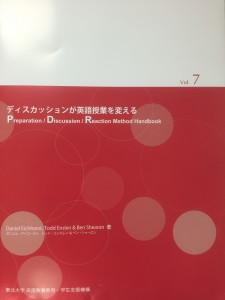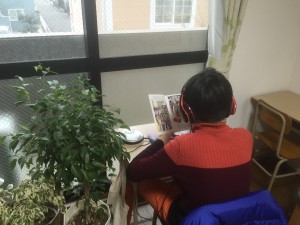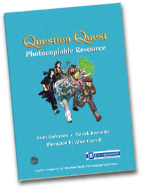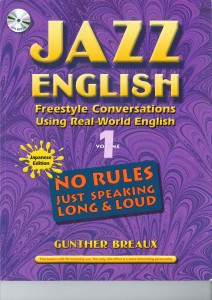Preparation Discussion Reaction: The PDR Method
How to get students speaking, discussing, and writing about real topics
Almost two years after it was first published, the PDR Handbook is finally available online.
PDR is a groundbreaking method for running 4-skills language classes for intermediate and above students. It can also be adapted for use with content classes. I have also used it successfully for teacher workshops.
You can download a copy of the Handbook in PDF format from here.
curriculum extensive listening extensive reading Language learning speaking
by sendaiben
12 comments
Shadoku Explained
Adding shadowing to beginner extensive reading has immense potential
I’ve been meaning to write this post for a while. I’d like to thank Yuko Suzuki, who first told me about the huge potential of incorporating shadowing practice into extensive reading classes for beginners/lower-level students. If you have a chance to see one of her presentations I recommend you take it -she’s a very effective teacher and presenter.
So what is shadoku? Well, it is a term coined by me as a gag over lunch at a seminar in Fukuoka. I’m kind of chuffed that it has been adopted somewhat by the community 😉
Shadoku is shadowing and tadoku (extensive reading).
Shadowing is a type of speaking fluency practice that involves attempting to speak along with another person or an audio source. It is different from repeating. When doing read and repeat, for example, the source would speak first, then the learner would repeat. In shadowing, the source would speak, then the learner would attempt to say the same thing at the same time with the smallest lag possible. One feature of shadowing is that learners are encouraged to imitate the speaker’s tone, intonation, emotion, and pronunciation.
This video gives a brief explanation of shadowing.
So how does this work with tadoku (extensive reading)?
Well, I have only been experimenting with this for a few months, and we rolled it out to all the beginner students in the Cambridge Academy last week.
I have adapted (messed up?) Yuko’s technique slightly, so I will introduce my version of shadoku below.
For beginners (mainly junior high school first years and elementary students) I am planning to do shadoku as described below until they reach YL 0.4, at which point I may allow them to read and listen instead, or we may continue with shadoku if that seems appropriate at the time. Basically this year is another learning experience for me.
How to do shadoku
There are four steps in my version of shadoku, so a student will read each book four times.
Step one: look at the pictures, think about the content. At YL0.1-0.3 there are plenty of pictures in the books and students can guess a lot of the content just from that. This step takes a minute or two, and we encourage students to look closely at details in the pictures.
Step two: listen to the audio and read along silently. This step allows students to focus on how to pronounce words and how the English sounds when spoken.
Step three: listen to the audio, read along, and shadow out loud. This step allows students to shadow assisted by the text.
Step four: listen to the audio and shadow out loud. Do not open the book. This step allows students to use their listening skills and short-term memory to shadow successfully. I also encourage students to think about the meaning of what they are saying during this step.
Introducing shadoku
For the first three or four classes I have students do shadoku as a group, with me leading them. I introduce each step (I have a notebook with the four steps that I show to remind students), play the CD when necessary, and give students feedback and advice. Students shadow together as a group, which makes them feel less self-conscious and allows more confident/keener students to set a good example.

I use these diagrams to explain shadoku
After a few classes and once students are more confident, we do group shadoku at the beginning of class and then students work individually with headphones and personal CD players in the latter half. They are also expected to continue practicing in the same way at home.
The benefits of shadoku
I haven’t been using shadoku with my students for long, but already I am really happy with how things are going. I’ve been asking all our new students (starting at YL 0.1) to do shadoku, and am currently planning to have them continue until they reach YL 0.4 or so.
The main benefit is that students are much more involved in the task.
Previously when we did reading while listening some students were clearly zoning out. I had a couple who appeared not to have made any progress mid-year so I had to have them go back to the beginning and do intensive work reading to me, etc.
I can’t see that happening this year, as I can hear the students practicing and can monitor if they are getting the right pronunciation, intonation, etc.
The students also seem happier and the atmosphere in class is much better than last year.
Conclusion
This is still a work in progress. So far so good, but we’ll see if students get bored or some unexpected problem pops up. We’ll also have to see where it would be appropriate to stop doing shadoku in class and transition to reading and listening. I suspect it’s going to be when students move from YL 0.3 to 04, but I’m not sure and look forward to trying it out in a couple of months’ time.
Anyone else using shadoku? Anything to add?
REVIEW: Question Quest Photocopiable Resource
A Useful Supplementary Resource
R.I.C. Publications was kind enough to send me a review copy of their new supplementary material for the Question Quest card game. As I wrote in my review of the game, I like it as a fun way to practice simple conversational strategies with junior high school and above students.
This new collection of photocopiable worksheets consists of:
- some pages of background information about the world the game is set in and the characters (pretty high level English)
- 74 worksheets, one for each of the question cards in the game
- supplementary materials, including two versions of a fun collaborative ‘boss battle’ variation game
The bulk of the resource is the worksheets, each of which includes some simple language practice first (grammar or vocabulary) followed by practicing the question as used in the game. The worksheets are visually appealing with some small pictures. Personally I found them a little crowded, but this is a reasonable compromise in order to fit all of the content onto one page. The language content is fairly simple and somewhat repetitive.
I can see two main uses for the worksheets in my class. The first is as something to do regularly as a language supplement, alongside playing the game. Every class I’d give the students one sheet, working through them all over a period of almost two years.
Another way to use them would be as a remedial resource: students who had trouble with a specific question card in the card game could be given the corresponding worksheet and a quick explanation.
Ultimately this resource is not able to (or designed to!) stand on its own. If you use the game in your classes you may find this a useful supplement. If you don’t use the game I would recommend checking Question Quest out. I wouldn’t say the worksheets are essential or necessary, but some teachers and students may benefit from the deliberate practice they provide.
You can see an example of one of the worksheets on the product page. It is similar to all the others.
EFL eikaiwa high school junior high school Language learning materials reviews speaking teaching textbooks university
by sendaiben
5 comments
Jazz English
Published by Compass, Jazz English is a speaking textbook for lower-intermediate students. It works very well with junior high school students that have been studying for a while and are ready to take things to the next level in terms of speaking, as well as with high school and I imagine lower level university students. I have only used the first textbook, so this review does not address Jazz English 2, nor the companion workbook (which I am going to try soon).
The textbook consists of ten main units and three supplementary ones, with all units following the same pattern: new vocabulary, conversation prompt questions, a dialogue, a short reading section, a crossword to practice the vocabulary, a short reading task, exercises to support speaking, and a final speaking activity.
The focus of the book is for students to develop more autonomy while speaking, and to try to have longer and more complex conversations. It does this very well, at least in my experience, with students that have a solid base of vocabulary and English exposure, and who are motivated to improve their conversational skills. Our ‘advanced’ classes, consisting of junior high and high school students that have been studying for four or more years took to it very well.
This has been a real find for us this year, and I wholeheartedly recommend it for classes similar to the one described above. The course requires a lot of student input, so this book would not work well with unmotivated or reluctant learners.
Anybody else using Jazz English?
curriculum expectations Language learning self-study speaking teaching teaching culture technology university
by sendaiben
leave a comment
Home Run Lesson
I just finished teaching a home run lesson (strange thing to say, as I am from the UK and don’t even understand how to play baseball) and am now compelled to write about it.
From this semester I have started teaching a class in a computer lab (you can read about the disastrous second lesson here). Today was a very different experience.
We had another tough class last week, where I gave the students too much work to do in too short a time. This week I wanted to give them a break, and put together something a bit lighter.
You can see the full lesson plan on my teaching blog.
This class has been weird for me. Partly it’s because of the physical properties of the computer lab, where students are much further away and more inaccessible than I am used to. Partly it’s the dynamics of the class, where I communicate with the students via blog, notebook comments, and email. And partly it’s because I have never taught this particular course before, so I’m making it up as I go along.
Today we explored a theme that I am very interested in having students think about. Part language identity poll and part wake-up call, the class examines Japanese speakers of English and asks the students to consider where they would fall on a scale ranging from non-English user to native-like speaker.
It seems I got the timing right this week, as the students all finished on time, but what really blew me away were the comments. I’m going to post a few below. The brackets show comments that were in Japanese originally. Translations are mine and may be inaccurate 🙂
Today’s work was good. I think about why we learn English again. I want to train my English skill, especially listening and speaking skill.
(I noticed that my English is really poor. I want to be able to understand spoken English at the very least. I’ll need English once I start working, so I want to get better at it while I am still a student)
Today,my motivation rised. I want to become well to speak English like them.In the future, I would like to interview without an interpreter.
It is good for me to see Japanese-speaker in the various phases.I think I am in no English, especially listening, so I will study English everyday and improve my English skill.
(I was completely shocked. I think I will study English more. Thank you)
It was nice to know a few Japanese who has different English skills. I noticed be able to speak English fluently is pretty hard.
Most students said similar things, which made me incredibly happy. My goal for this class was to get students thinking about why they might be studying English, and motivate them to push a little harder.
Now, this lesson is by no means perfect, and I’m already thinking about how to update and improve it, but I wanted to share it as it went down so well.
Has anyone done anything similar?




